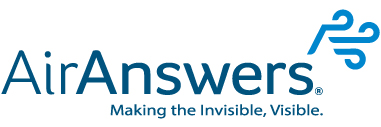So how do we actually identify Coronavirus in our samples?
Inspirotec’s revolutionary AirAnswers® device captures all biological particles down to 0.1 microns, including SARS-CoV-2 virus. Once it is captured, how do we identify SARS-CoV-2 in your collected air sample?
Hear directly from our lab team: For the detection of SARS-CoV-2, the Inspirotec lab uses a method known as RTqPCR (reverse transcriptase quantitative polymerase chain reaction). Essentially viral particles are taken from the sample and broken open to release the viral genetic material in the form of RNA. This RNA is too unstable to be amplified, so it is reverse transcribed into DNA to withstand amplification. Through PCR (polymerase chain reaction) DNA is amplified using DNA polymerase, additional reagents, and primers designed by the CDC to amplify targeted DNA segments, specifically for SARS-CoV-2. In order to amplify targeted DNA segments, DNA samples are placed in a state-of-the-art thermal cycler which performs rounds of amplification (or cycles) at specific temperatures until the signal is detected by the qPCR machine as it surpasses the threshold. The cycle time (CT value) is inversely related to the original amount of SARS-CoV-2 present in the air sample. For example, a high cycle time of 37 would indicate a lower amount of SARS-CoV-2 in an air sample compared to a cycle time of 23, which would indicate a higher viral load. The quantitative component of the report gives businesses an idea of the viral load present in the original sample which is a large clue to understanding if there was an isolated exposure to the virus or if it is an ongoing problem. Inspirotec recommends weekly monitoring as we adapt to the new normal.
To learn more about AirAnswers® please visit Airanswers.com or contact us directly at support@airanswers.com.










